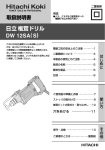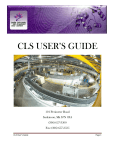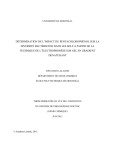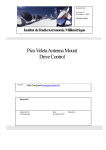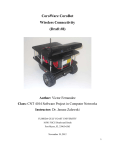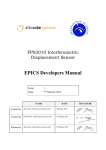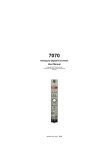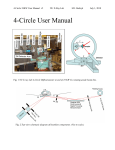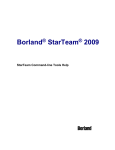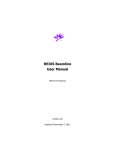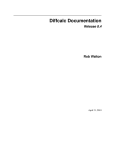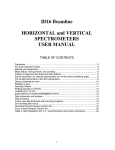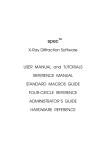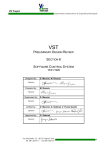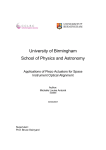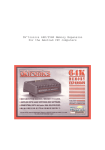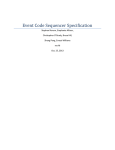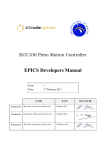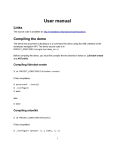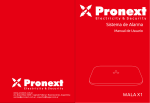Download REIXS Beamline Reference Manual
Transcript
REIXS Beamline Reference Manual (Work in Progress) Feizhou He Updated: April 28, 2015 TABLE OF CONTENTS 1.0 Introduction ................................................................................................ 1 2.0 Advanced Controls ..................................................................................... 1 2.1 3.0 3.2 Beamline Pump Down .................................................................. 1 2.1.2 RSXS Endstation Pump Down ...................................................... 1 2.1.3 Turn on the Electronics ................................................................. 1 Calibrating the Beamline Components ..................................................... 2 3.1.1 EPU Calibration ............................................................................ 2 3.1.2 Calibrating Apertures and Slits ..................................................... 3 3.1.3 Calibrating Mirror positions ........................................................... 4 3.1.4 Calibrating Chopper ...................................................................... 4 3.1.5 Monochromator Calibration........................................................... 5 Calibrating the Photon Energy.................................................................. 8 3.2.1 Calibration References ................................................................. 8 3.2.2 Tuning the Monochromator Energy Scale ..................................... 8 RSXS Endstation Setup ............................................................................. 9 4.1 4.2 4.3 4.4 5.0 2.1.1 Beamline Setup .......................................................................................... 2 3.1 4.0 Starting the Beamline from Scratch .......................................................... 1 RSXS Endstation Pump Down ................................................................. 9 4.1.1 Scattering chamber Pump Down .................................................. 9 4.1.2 Rotary Feedthrough Pump Down................................................ 10 4.1.3 Loadlock Pump Down ................................................................. 10 4.1.4 Transfer chamber Pump Down ................................................... 10 Setup RSXS Endstation Electronics ....................................................... 10 4.2.1 Detectors .................................................................................... 10 4.2.2 Scaler Setup ............................................................................... 10 4.2.3 Temperature Control Setup ........................................................ 11 Setup Motors and SPEC ........................................................................ 11 4.3.1 AML UHV Motors ........................................................................ 11 4.3.2 Attocube ANC350 Controller....................................................... 12 4.3.3 Macro Motors.............................................................................. 15 Setup SPEC Control .............................................................................. 15 XES Endstation Setup .............................................................................. 15 April 28, 2015 REIXS Beamline Reference Manual Page i 5.1 XES Endstation Pump Down .................................................................. 15 5.2 Setup XES Endstation Electronics ......................................................... 16 Appendix A: REIXS Beamline Motor Settings ..................................................... 17 Appendix B: REIXS Information .......................................................................... 18 Appendix C: Attocube Motor Settings ................................................................. 20 April 28, 2015 REIXS Beamline Reference Manual Page ii 1.0 Introduction The Resonant Elastic and Inelastic Soft X-ray Scattering (REIXS) Beamline is a soft X-ray beamline dedicated to soft X-ray scattering and soft X-ray spectroscopy experiments. The beamline is located at 10ID-2 port of Canadian Light Source. This document describes the setups and calibration of REIXS Beamline. 2.0 Advanced Controls 2.1 Starting the Beamline from Scratch All valves closed 2.1.1 Beamline Pump Down If one vacuum section has been vented, use turbo cart to pump down to below 10-6 Torr. Bakeout the section. Pumps, pump down individual vacuum sections, bakeout Before a power outage, close all gate valves to isolate each vacuum section. If the power outage is less than 2-3 days, usually the vacuum can be recovered by turning on the ion pumps in each section. Otherwise, use turbo cart to pump down each section to below 10-6 Torr before turning on the ion pump. 2.1.2 RSXS Endstation Pump Down Turbo pump for scattering chamber and load lock. Pump down the Cryo pump by either chamber turbo pump or through the roughing port on the cryo pump. Then start cryo pump. Pump down the Thermionics 2L/s ion pump for the rotary feedthrough differential pumping. Close the valve to turbo roughing line. Connect a turbo cart, open both valves on the differential pumping line. Pump the differential pumping line to <10-6 Torr, then start the ion pump. Current < 5mA?? Close the valve besides the 2L/s ion pump. Close the valve to turbo cart. Open the valve to 700L/s turbo roughing line. 2.1.3 Turn on the Electronics IOC1610-201 OPI1610-201 OPI1610-202 IOC1610-403 Start VME crates Start NIM crate Start control software for the beamline April 28, 2015 REIXS Beamline Reference Manual Page 1 3.0 Beamline Setup Power ready Air ready Cooling ready Vacuum ready. 3.1 Calibrating the Beamline Components 3.1.1 EPU Calibration For qualified beamline staff only. The REIXS EPU Control can be accessed by typing: runREIXS_Epu & from a command line window (xterm), or click the [R-EPU] button in the REIXS Advanced Control Interface. Clicking the [Calibrate EPU] button will bring up the EPU Calibration panel. Clicking [Run] button in the “Calibrate EPU” line will automatically calibrate all five motors on the REIXS EPU. Clicking other [Run] buttons will calibrate individual motors. When all the motors are calibrated, the calibration status shows Calibrated with green beackground. Other details of the REIXS EPU could also be accessed from this interface. DO NOT make adjustments without comprehensive knowledge of EPU control. April 28, 2015 REIXS Beamline Reference Manual Page 2 3.1.2 Calibrating Apertures and Slits REIXS Beamline has several apertures / slits. 3.1.2.1 Variable Aperture Variable Aperture 3.1.2.2 4-Jaw #1 and 4-Jaw #2 4-Jaw #1 and 4-Jaw #2 3.1.2.3 Exit Slit Exit Slit has four motors. Vertical gap: beam based calibration Inboard and outboard blade motors are the same as 4-Jaw motors. Roll motor April 28, 2015 REIXS Beamline Reference Manual Page 3 3.1.3 Calibrating Mirror positions For qualified beamline staff only. It is not necessary to move the mirrors for encoder calibration. Use procedure below for every motor / encoder pair for each mirror: 1. Open motor control interface for one motor. 2. Verify the settings for motor velocity, base velocity and acceleration. Make corrections if needed. 3. On Power/Backlash tab, turn off the Motor Power. 4. Go to Calibration tab, verify the values of Step Slope, Encoder Slope and Calib Position. Make corrections if needed. 5. Click the Home CW button. The motor feedback value should be changing. 6. Go to the corresponding motor, push the encoder tip back. Once the reference mark is detected, the motor feedback value will stop. The encoder is calibrated now. 7. Go back to Power/Backlash tab and turn on the motor power (or Auto Hardware for some motors). Other details of the motor could also be accessed from this interface. DO NOT make adjustments without comprehensive knowledge of motor control. 3.1.4 Calibrating Chopper Chopper must rotate in the positive direction for correct operation. If the chopper has moved in negative direction, it must rotate in positive direction for one revolution, so that the encoder can pass the home position reference mark and establish the correct angle readout. LED indicators on the Chopper Controller in the NIM Crate show the status of the chopper system. Once chopper is stopped, use “Move Relative” to adjust chpper position. [SYNCD] – Chopper calibrated [DS1] – Data stream 1 (REIXS EPU Beam) [DS2] – Data stream 1 (SM EPU Beam) April 28, 2015 REIXS Beamline Reference Manual Page 4 3.1.5 Monochromator Calibration For qualified beamline staff only. DO NOT make adjustments without comprehensive knowledge of monochromator control. Verify motor parameters: velocity, base velocity, accelaration Translation motors calibration In the “REIXS Energy” panel, click [ENABLE] button to activate the energy control. Use the input box to set the energy for monochromator and EPU. Click [Stop] button to stop all motors of monochromator and of EPU immediately. “Status” shows if the monochromator and EPU have reached correct setpoints. The [Disable/Enable] buttons are used to activate/deactivate individual components. 1.1.1.1 Selecting Gratings and M2 Coatings The REIXS monochromator has three gratings. There are four coatings the M2 mirror. In the “Monochromator” panel, user can select which grating and coating are used. The setpoint and feedback values are also displayed. April 28, 2015 REIXS Beamline Reference Manual Page 5 3.1.5.1 Configure EPU Access This panel is used to switch EPU access. Normal mode: [REIXS Only] 2-in-1 mode: [REIXS & SM] 1.1.1.2 Selecting EPU Harmonics Depending on the desired photon energy range, appropriate EPU harmonics shall be selected for optimum flux. For circular polarization, only the first harmonics can be used. For linear polarization, use the first harmonics for energy between 80 eV and 1000 eV. Use the third harmonics for energy between 800 eV to 2000 eV. Use the fifth harmonics for energy above 1500 eV. After executing the command to change EPU harmonics, the EPU does not respond immediately. The EPU harmonics will change the next time energy or polarization is changed. When the EPU control is established, the “Access” field shows “ENABLED” 3.1.5.2 Setup EPU Lookup Tables The [Configure EPU] button will bring up the panel for loading EPU lookup tables for gap and girder phase control. Polynomial April 28, 2015 REIXS Beamline Reference Manual Page 6 1.1.1.3 Monochromator Parameters Clicking [Configure Mono] button will bring up the following panel. In this panel, various monochromator parameters can be configured. This is to be used by beamline staff only. Grating parameters Line Density Position b2 Grating offset Mirror Offset Mirror position For both grating and mirror Max retry: 0 Deadband: 0.00005 Percent approach: 100% April 28, 2015 REIXS Beamline Reference Manual Page 7 3.1.5.3 IK320 Encoder interface For qualified beamline staff only. DO NOT make adjustments without comprehensive knowledge of monochromator control. For both M2 mirror and Gratings Sample rate 0.04sec 50Hz Initialization [Run Init] “Init completed: SUCCESS” Calibration [Card 1 + 2] and [RUN] “Calibrated” with green background 3.2 Calibrating the Photon Energy 3.2.1 Calibration References 3.2.1.1 Using Gas cell X-ray Photoionization of gas phase Nitrogen, Neon, Argon, Carbon monoxide or Carbon Dioxide, Oxygen 3.2.1.2 Solid references Through X-ray Absorption Spectroscopy (XAS) of well-defined absorption edges Metal, Ni, Stainless Steel Oxides: La edge, Ni edge, Si, graphite 3.2.2 Tuning the Monochromator Energy Scale The REIXS Mono Calibration panel is used to fine tune the monochromator calibration. The calibration needs to be carried out for each grating. April 28, 2015 REIXS Beamline Reference Manual Page 8 Using a calibration reference with known energy, optimize the flux by adjusting monochromator M2 mirror and grating pitch. Input the known energy into the red “Energy” box. Then input the two red “Offset” values into the corresponding “Grt Offset” and “M2 Offset” boxes. Click the Grating button above this column. The “USE” column will show the current used values. The monochromator is now calibrated to this reference energy. 1.1.2 Tuning the EPU Calibration To be done only after monochromator calibration. Needs to be done for each type of polarization. Scan EPU gap at each energy point. Using polynomial equations to calculate EPU gap. 4.0 RSXS Endstation Setup Need to reach UHV. Setup motors. Setup detectors. 4.1 RSXS Endstation Pump Down RSXS Endstation has several chambers. 4.1.1 Scattering chamber Pump Down The main scattering chamber has a Pfeiffer Turbo pump and a CTI cryo pump. Two gate valves 1. Open the gate valve to the turbo pump. If cryo pump is at room temperature, open the gate valve to the cryo pump. 2. Turn on roughing pump. 3. Turn on turbo pump. 4. Turn on ion gauge when the Convection gauge shows 0 5. Turn on cryo pump. The Lakeshore 211 Temperature Monitor shows the cryo pump temperature, ~15K during the normal operation. RGA on the Scattering Chamber. April 28, 2015 REIXS Beamline Reference Manual Page 9 4.1.2 Rotary Feedthrough Pump Down The 2L ion pump on rotary feedthrough needs to be pumped down before start. 1. Close the valve to the main chamber roughing line. 2. Connect a turbo cart to the pumping port for the rotary feedthrough. 3. Open the valve between the first and second stage of the rotary feedthrough. 4. Turn on the turbo cart. 5. When the turbo cart reaches base pressure, turn on the small ion pump. Green light 6. Close the valve between the first and second stage of the rotary feedthrough. 7. Open the valve to the main chamber roughing line. 8. Close the valve to the pumping port for the rotary feedthrough. 9. Stop the turbo cart. 4.1.3 Loadlock Pump Down Pfeiffer Turbo pump: 1. Close loadlock door. Close gate valve. 2. Turn on roughing pump 3. Turn on turbo pump. The venting valve will close automatically. 4. Turn on ion gauge when the Convection gauge shows 0 4.1.4 Transfer chamber Pump Down 4.2 Setup RSXS Endstation Electronics Turn on power to the NIM Crate and VME Crate in the endstation electronics rack. 4.2.1 Detectors Photodiode: connected to Electrometer through a Triax cable TEY: SR-570 Current Amplifier Channeltron: Ortec Micro-Channelplate (MCP): 4.2.2 Scaler Setup SIS3820 Scaler Setup Input Mode: Mode 4 Output Mode: 2 April 28, 2015 REIXS Beamline Reference Manual Page 10 Mode: Continuous Source: Clock 4.2.3 Temperature Control Setup Lakeshore 325 Temperature control Temperature Sensor: Si Diode DT-670 Heater: 25 Ω, 25W max PID setting 4.3 Setup Motors and SPEC There are nine AML UHV motors and two Attocube piezo motors in the Scattering chamber. 4.3.1 AML UHV Motors The AML UHV motors are controlled by SPEC as epics motors. The APS motor record connects to CLS motor record through a wrapper software. Motor parameters: TTH, tth, … Motor temperature: Omron Temperature monitor, keep temperature below 65°C. April 28, 2015 REIXS Beamline Reference Manual Page 11 4.3.2 Attocube ANC350 Controller The two piezo motors inside the polarization analyzer are controlled by the Attocube ANC350 Controller. Initial setup To setup the Attocube controller and motors, quit FOURC first. After power on the ANC350, from Windows computer, open the Attocube folder on the desktop. The software “dgdiscvr.exe” is used to setup the IP address for the ANC350 controller. The ANC350 is connected to the REIXS VLAN (642) Host name: MC2E1610-401 Domain: clsi.ca Static IP address: 10.52.11.100 Subnet mask: 255.255.252.0 Default Gateway (routers): 10.52.11.254 Confirm the network connection is established. Software “daisy.exe” is used to setup the motor parameters. Open the “daisy” software. It will try to connect to the ANC350 server. Once connected, the left indicator at the bottom will be green. If it failed to connect to ANC350, click the “start” icon (like a thunderbolt) to try again. April 28, 2015 REIXS Beamline Reference Manual Page 12 Once connected to the ANC350, click “Open File” icon, and select “ANC350_3.ngp” profile. There will be four tabs opened in “Daisy” interface. The first tab is Global Settings. Keep the default values. The second tab is for ANR101/RES Motor. This motor is used to position the multilayers for either horizontal polarization or vertical polarization. The default motor profile can be loaded using “Load Actor profile” button and then choose “ANR101res_95_171.aps” file. April 28, 2015 REIXS Beamline Reference Manual Page 13 Uncheck the “Target Ground” checkbox. This parameter could not be changed within FOURC. The third tab is for ANRv51/RES Motor. This motor is used to change the multilayers and also to scan the analyzer theta angle. The default motor profile can be loaded using “Load Actor profile” button and then choose “ANRv51_C4_029.aps” file. Also uncheck the “Target Ground” checkbox. The fourth tab (ANC350 Axis 3) is not used. Now close all tabs by clicking the “close” icon (red cross). And then disconnect the ANC350 server by clicking the “shutdown” icon (blue handgun). The ANC350 front panel is shown above. The first slot is the master module, and shows the driving voltage of the module in focus. The second and third modules are for the Analyzer and ATH motors, respectively. The current angular position or holding voltage is shown. Refer to Attocube User Manual for more information. Setup in FOURC Start SPEC using “runFOURC”. If you see startup message as following, quit SPEC and try again (or use “reconfig”): Getting configuration parameters from "SPECD/fourc/config". Bad packet from Attocube. Purported Attocube ANC350 on "MC2E1610-401.clsi.ca" is unusable. ANC350 motor "ana" (unit 0, ch 0) unusable: controller unresponsive. ANC350 motor "ath" (unit 0, ch 1) unusable: controller unresponsive. April 28, 2015 REIXS Beamline Reference Manual Page 14 The following startup message means communication with ANC350 has been established: Getting configuration parameters from "SPECD/fourc/config". Using Attocube ANC350 (fw 0.0.2.1 new) on "MC2E1610-401.clsi.ca". Found ANC350 chan 0 for "ana", resistive, 0.011 deg/step Found ANC350 chan 1 for "ath", resistive, 0.031 deg/step The two motors are: Analyzer ana ANR101/RES ATH ath ANRv51/RES Both ana and ath motors have resistive encoders. The real time position is displayed on the ANC350 front panel. From SPEC, use motor_par() function to change the motor parameters. Refer to SPEC help page “Attocube” for more information. Be careful the unit of the parameters. If FOURC reports discrepancy between the setpoint and feedback, answer “no” to keep using the encoder (feedback) value as the true motor position. motor_par(ana,"dump") and motor_par(ath,"dump") commands can be used to list all the parameters for Attocube motors. See Appendix C for typical parameters. 4.3.3 Macro Motors The photo energy is a macro motor in SPEC – engy Voltage Source? Linear Inclined Polarization angle – lian 4.4 Setup SPEC Control SPEC control Config: Motors, Devices, Scalers Macros: Macro Motors, Macro Hardware, Pre and Post Polarization, harmonics Energy Sample Temperature 5.0 XES Endstation Setup 5.1 XES Endstation Pump Down Sample Chamber Grating Chamber April 28, 2015 REIXS Beamline Reference Manual Page 15 Detector Chamber 5.2 Setup XES Endstation Electronics Motion control Gratings Microchannel Plate (MCP) April 28, 2015 REIXS Beamline Reference Manual Page 16 Appendix A: REIXS Beamline Motor Settings Motor Settings April 28, 2015 REIXS Beamline Reference Manual Page 17 Appendix B: REIXS Information [telnet] telnet ioc1610-201 10000 application ioc port variableAperture reixsMotors reixsChopper HHEncoder reixsEnergy IOC1610-201 IOC1610-201 IOC1610-201 IOC1610-201 IOC1610-201 10000 10001 10002 10003 10004 variable aperture for SM and REIXS motors on REIXS beamline chopper on REIXS beamline encoders for REIXS mono set up energy on beamline uofsMotors apsMotors IOC1610-201 IOC1610-201 10011 10021 motors for U of S endstation motors for UBC endstation picoammeter picoammeter IOC1610-108 IOC1610-022 10000 10000 picoammeters in POE picoammeters along beamline keithleyMeter LakeShore325 SIS3820 IOC1610-401 IOC1610-401 IOC1610-403 10000 10001 REIXS Keithley Meters for RSXS REIXS Lakeshore Controller for RSXS SIS3820 Scaler for RSXS [Example] control@OPI2031-001:181 >telnet ioc1610-201 10002 Trying 10.52.8.2... Connected to ioc1610-201.cs.clsi.ca (10.52.8.2). Escape character is '^]'. @@@ Welcome to the procServ process server (procServ Version 2.4.0) @@@ Use ^X to kill the child, auto restart is OFF, use ^T to toggle auto restart @@@ procServ server PID: 29993 @@@ Server startup directory: /etc/rc.d/init.d @@@ Child startup directory: /iocApps/REIXS_Beamline/IOC1610-201/REIXS_IK320_Encoders @@@ Child started as: /bin/sh @@@ Child "/bin/sh" PID: 30749 @@@ procServ server started at: Jul 02, 2009 11:00:56 AM @@@ Child "/bin/sh" started at: Jul 02, 2009 11:14:15 AM @@@ 2 user(s) and 0 logger(s) connected (plus you) ^C ^R ^] quit Kill restart talk to telnet exit telnet April 28, 2015 REIXS Beamline Reference Manual Page 18 [Restart Sub-Process] [Example] Fix mono mirror angle glitch: telnet IOC1610-201 10003 telnet into the IOCApp ProcServe: seqShow list processes: seqStop monoAngle stop unresponsive process (monoAngle for mono glitch) To lookup the restart command, find iocApp in directory /iocApps/REIXS_Beamline, eg: /iocApps/REIXS_Beamline/IOC1610-201/REIXS_IK320_Encoders (for mono glitch) st.cmd contains the seq commands with the required parameters (there are two for the mono glitch): seq monoAngle "deviceLabel=GRATING, monoDevice=MONO1610-I20-01:grating, unit=deg, motor=SMTR1610-I20-04, encoder=ENC1610-I20-04, motorUnit=mm" seq monoAngle "deviceLabel=MIRROR, monoDevice=MONO1610-I20-01:mirror, unit=deg, motor=SMTR1610-I20-02, encoder=ENC1610-I20-02, motorUnit=mm" Run these command from the procServe telnet session to restart the process. [Clear Registers] Start up application with VME could run out of registers. Use /iocApps/vme-commands/clearMaps Need to logon to IOC1610-201 /iocApps/1100_drv/clearMaps /iocApps/1100_drv/clearMaps application /iocApps/1100_drv/clearMaps application /iocApps/1100_drv/clearMaps /iocApps/1100_drv/clearMaps [Computer ID] REIXS Main IOC: REIXS OPI: RSXS IOC: RSXS Temp: /dev/sis1100_1 0 /dev/sis1100_1 1 5 will clear register (0) for VA application will clear registers (1-5) for reixsMotors /dev/sis1100_1 6 will clear register (6) for reixsChopper /dev/sis1100_1 /dev/sis1100_2 will clear all registers will clear all registers for IK320 IOC1610-201 OPI1610-203, OPI1610-204 IOC1610-403 IOC0000-045 Tony's computer: OPI2031-001 /home/wilsont/Epics/Sandbox/epics_local/cs-apps/Beamlines/REIXS_Beamline April 28, 2015 REIXS Beamline Reference Manual Page 19 Appendix C: Attocube Motor Settings Typical Attocube motors parameters. Some parameters will be updated during operation. Some parameters are read-only (ro). Refer to SPEC help page “Attocube” for more information. ana motor 296.FOURC> motor_par(ana,"dump") Direction: Loop gain = Loop offset = Approach speed: Setpoint for speed feedback: Speed feedback factor = Speed feedback sensitivity = Amplitude = Capacitance (ro) = DC level = Frequency = Hump detection: Maximum amplitude = Maximum frequency = Max position for actuator (ro) = Min position for actuator (ro) = Optical sensor periods = Position (ro) = Minimum position of sensor = Maximum position of sensor = Position loop time = Reference offset = Reference position (ro) = Reference voltage (global) = Output relays = Movement type: Sensor-average factor = Sensor direction: Internal signal averaging = Sensor units = Shortest way algorithm: Target approach speed = Speed (ro) = Approach speed gain = Step width (ro) = Sticky hump: Hump sensitivity = Minimum steps for hump = Minimum time frame for hump = Position feedback factor = Position feedback sensitivity = Positioning accuracy = Minimum hold-time for success = Resistive transfer gain = Sensor type: forward (0) "actordir" 0.00041 deg/V (410) "actorgain" 15000 mV "actoroffset" disabled (0) "adaptsetpctrl" amplitude (1) "amplctrl" 1 "amplctrlavg" 10 (10000) "amplctrlsensitivity" 42000 mV "amplitude" 1684 "capacitance" 12447 mV "dclevel" 2000 Hz "frequency" enabled (1) "humpenable" 70000 mV "maxampl" 2000 Hz "maxfrequ" -272000 deg (-271999936) "maxpos" -272000 deg (-271999936) "minpos" 1000 per deg "period" 159.002 deg (159002) "position" 0 deg "positionmin" 320 deg (320000) "positionmax" 0.0005 ms (500) "poslooptime" 0 deg "refoffset" 1.129 deg (1129) "refpos" 2000 mV "refvolt" 1 "relays" rotary (1) "rotary" 6 "sensoravg" forward (0) "sensordir" 6 "sensorres" 20 deg "sensorunit" disabled (0) "singlecircle" 0.01 deg/sec (10000) "slowspeed" 22.14 deg/sec (22140) "speed" 1 Hz (1000) "speedgain" 0.011 deg (11) "step_width" enabled (1) "stickyhump" 200 deg "humpsensitivity" 10 steps "humpstepsmin" 500 msec "humptime" 6 "targetctrlavg" 8000 (8000000) "targetctrlsensitivity" 0.002 deg (2) "targetrange" 300 msec "targettime" 332.03 deg/V (332030) "transfergain" resistive (1) "transfertype" ath motor 297.FOURC> motor_par(ath,"dump") Direction: Loop gain = Loop offset = Approach speed: Setpoint for speed feedback: Speed feedback factor = Speed feedback sensitivity = Amplitude = April 28, 2015 forward (0) 0.0014 deg/V (1400) 5200 mV disabled (0) amplitude (1) 1 10 (10000) 28000 mV "actordir" "actorgain" "actoroffset" "adaptsetpctrl" "amplctrl" "amplctrlavg" "amplctrlsensitivity" "amplitude" REIXS Beamline Reference Manual Page 20 Capacitance (ro) = DC level = Frequency = Hump detection: Maximum amplitude = Maximum frequency = Max position for actuator (ro) = Min position for actuator (ro) = Optical sensor periods = Position (ro) = Minimum position of sensor = Maximum position of sensor = Position loop time = Reference offset = Reference position (ro) = Reference voltage (global) = Output relays = Movement type: Sensor-average factor = Sensor direction: Internal signal averaging = Sensor units = Shortest way algorithm: Target approach speed = Speed (ro) = Approach speed gain = Step width (ro) = Sticky hump: Hump sensitivity = Minimum steps for hump = Minimum time frame for hump = Position feedback factor = Position feedback sensitivity = Positioning accuracy = Minimum hold-time for success = Resistive transfer gain = Sensor type: April 28, 2015 2077 "capacitance" 16224 mV "dclevel" 2000 Hz "frequency" enabled (1) "humpenable" 70000 mV "maxampl" 2000 Hz "maxfrequ" 88.123 deg (88123) "maxpos" 83.217 deg (83217) "minpos" 1000 per deg "period" 15.002 deg (15002) "position" 0 deg "positionmin" 325 deg (325000) "positionmax" 0.0001 ms (100) "poslooptime" 0 deg "refoffset" 4.098 deg (4098) "refpos" 2000 mV "refvolt" 1 "relays" rotary (1) "rotary" 6 "sensoravg" forward (0) "sensordir" 6 "sensorres" 20 deg "sensorunit" disabled (0) "singlecircle" 0.01 deg/sec (10000) "slowspeed" 63.839 deg/sec (63839) "speed" 1 Hz (1000) "speedgain" 0.031 deg (31) "step_width" enabled (1) "stickyhump" 200 deg "humpsensitivity" 10 steps "humpstepsmin" 500 msec "humptime" 6 "targetctrlavg" 1000 (1000000) "targetctrlsensitivity" 0.002 deg (2) "targetrange" 300 msec "targettime" 341.483 deg/V (341483) "transfergain" resistive (1) "transfertype" REIXS Beamline Reference Manual Page 21
























